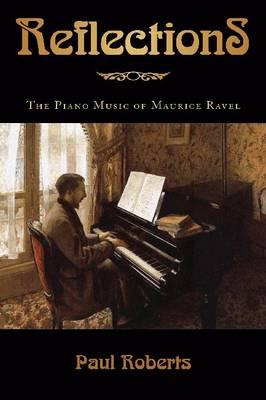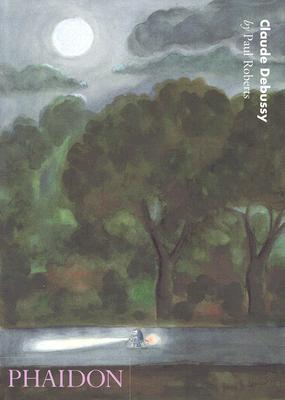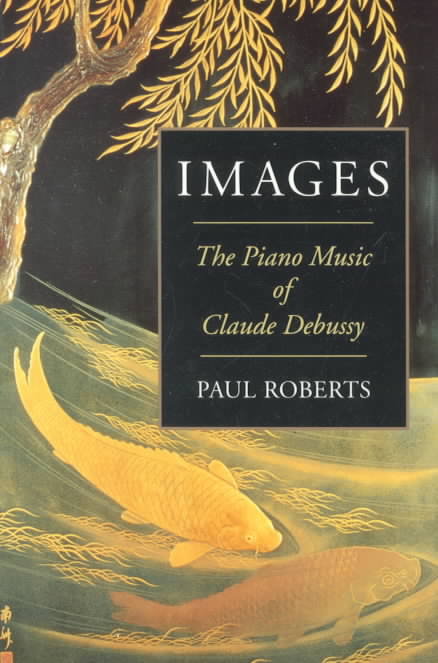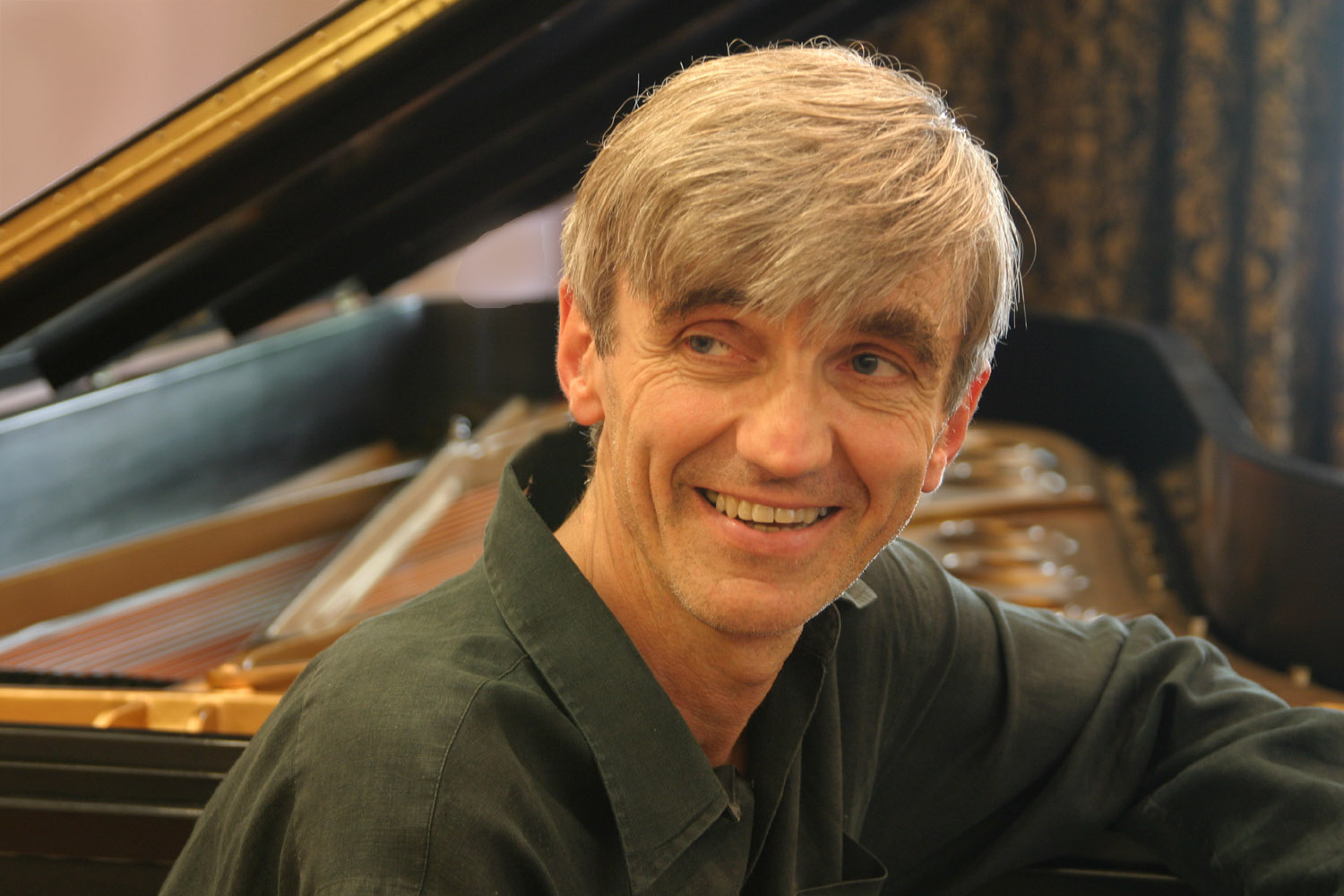The Case of Ravel
In this exclusive interview pianist Paul Roberts talks about his new book Reflections and the search for pathways into the core of musical interpretation.
 Patrick Jovell: It has been a fascinating journey reading your book and I must say that it’s not only a book about Ravel but rather about the sources and states which are required in order to understand the transcendence of music. I understand “the case of Ravel” does propose many angles of such a process but does it also reflect your own way when approaching other composers’ music as well?
Patrick Jovell: It has been a fascinating journey reading your book and I must say that it’s not only a book about Ravel but rather about the sources and states which are required in order to understand the transcendence of music. I understand “the case of Ravel” does propose many angles of such a process but does it also reflect your own way when approaching other composers’ music as well?
Paul Roberts: The somewhat over-used word today to describe this process is ‘holistic’. I believe this process is crucial, in fact for me it is self evident. I have never been able to accept that art, in whatever form, is something ‘out there’, detached, framed, separated, hence unconnected to our essential selves. We all know that art is an expression, in however complex a way (and often in a very simple way) of our own experience, our view of the world from diverse angles. If this is obviously true of novels, plays and poetry (the written and spoken word being more or less an exact response to the need for ‘something to say’) then I want it to be true of music too. I think we should be able to talk about music in relation to our experience outside music. I recognise, of course, that the correlation between music and the experience to which it is connected is much more difficult to isolate and bring forward for discussion, music being essentially abstract and lacking the concrete meanings of language. It is sometimes easier to talk about music from the 19th and early 20th centuries (so-called Romanticism and Impressionism) but it should be equally possible to talk in this way about Bach, Mozart, Beethoven and even Stockhausen.
So yes, my preparation for performing and teaching any music by any composer begins from a profound respect for the sources of inspiration, whether personal, literary, historical, stylistic. We need to engage with why the music exists at all and not simply treat it as a problem to be solved in a technical sense, to be learnt, performed and discarded.
And one further point is relevant to my own approach: I believe that the performing musician should be very aware of how other art forms operate, how other artists grapple with problems of expression, of form, of communication. If an actor needs to immerse herself in the flavour and manners of a period, in order to ‘act’ with complete veracity, then a musician should too. How can we perform Ravel’s Valses nobles et sentimentales if we don’t understand the risqué nature of a waltz, or Ravel’s stated intention that these waltzes were inspired by early 19th-century Vienna? The ironic tension between Ravelian harmony on the one hand, and the ever-present limitation of the three-four time structure on the other, redolent of Schubert’s waltzes, is the very condition that produces this supremely great work of art. (See my chapter on Valses nobles in my book!)
It is by engaging with other art forms that one can come across such wisdom as the following, from the theatre director Peter Brook: ‘An actor must never forget that a play is greater than himself.’ Pianists should take heed.
PJ: The celebration of the Debussy anniversary makes me think of your book on Debussy (2008) and the book Images (2003) on Debussy’s piano music. Can you pinpoint your personal affinity for Debussy and Ravel?
 PR: I discovered Debussy first, in my teens, and it was many years before I tackled Ravel. Being a slow learner and absorber I needed years before I felt able to say something about Debussy. Once I had got there – and I’m certainly not saying I am finished, the learning process is endless – I suddenly saw Ravel across the other side of the valley, it was almost a relief and a liberation to turn to something so utterly different from Debussy yet intimately connected both artistically and of course historically.
PR: I discovered Debussy first, in my teens, and it was many years before I tackled Ravel. Being a slow learner and absorber I needed years before I felt able to say something about Debussy. Once I had got there – and I’m certainly not saying I am finished, the learning process is endless – I suddenly saw Ravel across the other side of the valley, it was almost a relief and a liberation to turn to something so utterly different from Debussy yet intimately connected both artistically and of course historically.
The affinity stemmed from a simple romantic attachment to all things French in my teens, and I have to say it was the music of Debussy, when I first heard it (La fille aux cheveux de lin, and Prélude à l’après-mid d’un faune, then Pelléas at university), that drew me to all things French. It spoke so strongly to me, it chimed in with my own secret desires and ideals, and I simply wanted to find out more and more. So I read about him – a recall a dreadful hagiography entitled Clair de lune which thrilled me at 16 (I still have a copy on my shelf). I listened endlessly, learnt piano pieces, and even at 21 dreamed of writing a book that would engage with all the solo piano music – at that time I called it Music and Painting. It took nearly 30 years to come to full fruition (my Images), and a good thing too.
 I was fascinated by Debussy the man, and above all by the way the man was not only shaped by his times, but how he shaped those times himself. This above all developed my interest in the holistic approach to preparation and interpretation. Of course Debussy’s music can be taken as it is – the greatest art will always withstand myriad approaches and myriad interpretations, and I don’t deny that the greatest art is also self-contained – but it would be a foolish performer who didn’t at least pay some attention to Debussy’s own experiences of painting, poetry, oriental music, Japanese art and the music of Wagner and the Russians. It is but a short step to become interested in the life – for example, in Debussy’s highly attractive role as a father, and his relationship with his daughter that led to the composition Children’s Corner.
I was fascinated by Debussy the man, and above all by the way the man was not only shaped by his times, but how he shaped those times himself. This above all developed my interest in the holistic approach to preparation and interpretation. Of course Debussy’s music can be taken as it is – the greatest art will always withstand myriad approaches and myriad interpretations, and I don’t deny that the greatest art is also self-contained – but it would be a foolish performer who didn’t at least pay some attention to Debussy’s own experiences of painting, poetry, oriental music, Japanese art and the music of Wagner and the Russians. It is but a short step to become interested in the life – for example, in Debussy’s highly attractive role as a father, and his relationship with his daughter that led to the composition Children’s Corner.
Following up these threads leads to the very nature of the creative process, which for me can be expressed by a straightforward question: how does the person Claude Debussy become the artist Claude Debussy? Can the two sides of this question actually be separated? If that seems a somewhat obscure, perhaps over-academic, approach for performing artists, then how about a question closer to home: how does the person Paul Roberts (fill in your own name) become the performing artist Paul Roberts (fill in your own name)? I do believe that for our health and well being, and thus for the validity of our art, we should all know from what material – experiences, inner compulsions – our creative impulses spring.
So it was a logical step that I should be drawn into writing a biography of Debussy. I originally considered that Ravel’s life would not interest me – it never had especially – but on turning at last to his piano music and realising that I not only wanted to perform it but also write about it, I soon discovered what a profoundly complex and fascinating ‘case’ the man himself offered. The more I explored the life, the more was I drawn to Ravel’s inner world, and the more I felt I understood the extraordinary qualities of his art. Reflections is not a biography of Ravel: it is a book about the piano music. But inescapably I found that I couldn’t write about the music without reference to the man.
PJ: A thrill for the reader, you are very concerned with the pianist collaborations with contemporary pianists like H. Faure, Viñes and Perlemuter and refer to them as messengers to the future. As a modern pianist, how do you listen to them and what in particular are you looking for? I gather there is a fine line between imitation, inspiration and analysis?
 PR: It is fascinating and highly instructive to hear how pianists of the past played. It brings us down to earth, and helps us realise that interpretation is absolutely not an exact science and that what we ‘do’ today is partly to do with current tastes and fashions. So I marvel at the performances without ever wanting to imitate them. One couldn’t – it would be like walking around in the clothes from another era, complete with wig and silk stockings (or in Ravel’s case silk cravates, impeccably pressed trousers and spats).
PR: It is fascinating and highly instructive to hear how pianists of the past played. It brings us down to earth, and helps us realise that interpretation is absolutely not an exact science and that what we ‘do’ today is partly to do with current tastes and fashions. So I marvel at the performances without ever wanting to imitate them. One couldn’t – it would be like walking around in the clothes from another era, complete with wig and silk stockings (or in Ravel’s case silk cravates, impeccably pressed trousers and spats).
But we soon learn to distinguish between surface fashions (the frequent arpeggiation of chords for example, apparent in some of Ravel’s own piano roll recordings) and the essence of the music. What never fails to come across in the finest performances – what for me actually defines a fine performance – is the nature of phrasing, the ease of movement within the music, the flow and intelligibility of direction. Perlemuter in particular is a master of this. Unfortunately there are very few recordings of Viñes, and none in which he plays Ravel (Debussy’s Soirée dans Grenade he plays with tremendous Spanish flair and quite fast.). You don’t mention Walter Gieseking (and nor do I in the book) but he exemplifies refinement of phrasing in his Debussy and Ravel recordings. I listen for this, or I am at once struck by this – which is a constant source of aesthetic pleasure – irrespective of the ‘interpretation’, which I find is secondary. What I mean is, we would never play like that today, in terms of tempo, or rubato, but we should certainly aspire to that ease and rightness of phrasing.
And Ravel manifests this too in his piano roll recordings. His performances are often clumsy, full of errors, and often too fast, yet the musical flow, the engagement with musical meaning, is extraordinarily present.
PJ: As a consequence of the Debussy anniversary there is now a broad musicological and artistic discussion whether Debussy was an Impressionist or not, and some voices state the importance of pure classical idioms being tremendously important for Debussy, for example. Should or could Debussy and Ravel be compared at all? Many a pianist is used to “Impressionist Piano Music” compilations by the recording industry as well as among major musical editions.
PR: I think the Impressionist label is a necessary convenience – after all it does denote a historical period and a certain style of music – though I abhor the consequent attitude that the music is therefore ‘merely’ picturesque. It is extraordinary how pervasive the view still is in certain countries that Germanic music has greater depth, greater spiritual and intellectual dimensions. So yes I am all for the new attitudes to Debussy and Ravel that show how grounded their music is in rigorous musical procedures. I am constantly pointing out in my teaching how crucial it is in preparing Debussy to understand the precision of his rhythmic structures, how the apparent freedom of his phrasing and the disembodied textures by which the music appears to escape gravity, are all dependant on a strict observance of pulse and an awareness of complex harmonic relationships.
And yet . . . how would it be possible to conceive the full genius of La mer without recognizing that the creative impulse behind this vast symphony (which really does observe processes of symphonic form and development, and which Debussy himself, the arch-enemy of academia, called a ‘symphony’) is the sea itself, and the meaning, both psychological and real, that the sea holds for mankind? The title was not added as an after thought.
Yes most certainly Debussy and Ravel can be compared within the Impressionist genre – both wrote within and outside it. In the piano works Ravel is an ‘Impressionist’ in Jeux d’eau and Miroirs (and with titles such as those how could he not be? – titles comparable to the invitations provided by Debussy’s Images and La mer). In Valses nobles on the other hand, and Le tombeau de Couperin, he is definitely not, just as Debussy is not in Suite bergamasque and the Etudes.
PJ: France, at the turn of the last century was the scene for the most important Symbolist writers and the multi-possibilities of the language became a stylistic sign of this whole movement. When clarifying the musical essence of Ravel’s works your references to literature go hand I hand. What are the differences or similarities between a Ravel/Fargue collaboration and a Chopin/Mickiewicz or a Liszt/Goethe?
PR: I think there are very strong similarities. My next research project, which I am undertaking right now at the Guildhall School of Music & Drama in London, is a logical extension of my interest in this field. I am looking at all those many piano works of Liszt that were inspired by literature. The result will be recordings and another book, working title Liszt and Literature. So not only Liszt/Goethe (you are alluding to the Faust Symphony, and to Liszt’s life-long interest in Faustian themes and images) but, in the piano music, Liszt/Petrarch, Liszt/Sénancourt (Vallée d’Oberman) Liszt/Dante – and many other collaborations.
The Chopin/Mickiewicz collaboration has had some attention, but it is more tenuous and for this reason doesn’t absorb me in the same way. But certainly the very use of the word Ballade implies a whole symbolic relationship, if not a real one, between music and story telling. This, in general terms, certainly does interest me. The presence of what one might call narrative tension, or narrative structure, is palpable in music, whether in a sonata, in a tone poem or in the Faust Symphony. The narrative tension of Liszt’s B minor Sonata is one of its most arresting features, apparent at once, and which never lets us out of its grip. But there is not a shred of literary context. One of the greatest examples of ‘pure’ music, it was nevertheless regarded in the 19th and early 20th centuries as somehow a narrative of Liszt’s life, a biography. This is an unfashionable approach to this mighty work today, but it is by no means to be derided. The presence of the single motif in every detail of the work provides that sense of both security and intelligibility that we get from popular art forms, yet it also sets up, at times, an electrifying dramatic tension that comes from the motif managing to undergo constant transfigurations while remaining the same. This is a perfectly acceptable metaphor for a human life – though whether Liszt intended it is another matter. But to return to a comment I made earlier, the performer should be always inquiring into the sources of the creative process, and not, then, assume that the simple (or not so simple) marshalling of thematic material is the sole reason for the greatness of the B minor Sonata.
As regards literature the irony is that Debussy was far more inspired by Symbolist poetry and drama, and in literature in general, than ever he was by Impressionist painting. So in many respects the Impressionist label, to return to your previous question, is a false one. But I take musical Impressionism to mean any association outside the musical sphere, any descriptive music, so for me Liszt is an Impressionist throughout the three books of Années de pèlerinage, as is Schumann in Kreisleriana (inspired by the writing of E T A Hoffmann). And Ravel in particular belongs to this 19th-century tradition: the three poems which inspired Gaspard de la nuit he appends to the score, so as to be read by the performer and directly related to the music under the fingers – which was exactly Liszt’s practice in the Petrarch Sonnets. In Miroirs Ravel was more secretive – and one of the most exciting discoveries I made when researching my chapter on Miroirs was how the music was intimately related to Ravel’s close friendship with the poet Léon-Paul Fargue, who would have been reading his new poems to the group known as the Apaches at exactly the same time as Ravel would have been introducing his new piano pieces. Fargue was an inspiration to Ravel, his literary mentor and a vital catalyst for his musical imagination. Fargue himself was fascinated by music, Ravel’s and Debussy’s in particular, and his poetry is replete with musical allusions.
PJ: Les Apaches or Société des Apaches — in which the poet Fargue was a member — was a group of some sixteen French musicians, writers and artists which formed around 1900 who had rallied around Debussy’s opera Pelléas et Mélisande. In French Les Apaches also meant “hooligans”. There were other artistic groupings in Paris at that time. In which various ways did Les Apaches form a base for Ravel?
They were ‘Hooligans’ because the young men (no women) were rowdy at concerts in support of their favoured composers – and for the fact that they liked to see themselves as apart, as an avant-garde élite. I would go so far as to say the Apaches group was the most important event/experience of Ravel’s formative years, without which his art would not have developed as quickly or as soon as it did. It was not only Fargue’s presence – though he was the most important of the non-musicians of the group for Ravel – but the whole set and setting, the ready ears, the ready and provoking discussions on art and life, the friendship and loyalty which enabled Ravel’s art to burgeon in a supportive atmosphere (though the group were sometimes mystified by it: Oiseaux tristes was at first regarded as inexplicable). And then there was the brilliant Spanish pianist Ricardo Viñes, a friend from Ravel’s childhood, who became one of the most significant pianists of the age for the promotion of new music. If Ravel wasn’t playing to the group it would be Viñes (as well as the painter Paul Sordes, who by all accounts was an able amateur pianist; as a painter Sordes was dubbed ‘the Ravel of the palette’.) We owe Gaspard de la nuit to Viñes , who not only introduced the original prose poems to Ravel (by Aloysius Bertrand) but who sat, literally, by his side during its composition. Viñes was a formidable virtuoso, and though Ravel had some skill he could not have performed the work as Viñes would have done.
It is highly significant for our understanding of Ravel’s art that the group was made up of a cross section of artists: poets, writers and critics, painters, composers, pianists. The phenomenon of cross-arts discussion, collaboration, mutual inspiration – which was a guiding principal of French Symbolism in the 1890s, and a strong current in Romanticism throughout the 19th century – had its continuation in the Apaches.
Hear Paul Roberts in interview on Debussy at NPR’s On Point:
Comments
Wow excellent reflection.
Although I can consider myself little more than a dilettante in the music world (and at age 85 will probably never be more than that!) I was fascinated by your comments. Your association of musical ideas of a given period with its literary forms recalled a paper I wrote when I returned briefly to school in the late 1980’s, entitled “Gothic Architecture in Sound and Stone”, in which I compared the growth of music from monophony through polyphony with concurrent changes in architectural styles from Romanesque to Gothic. Not only the sound of the music, but its appearance on the written page proceeded almost hand in hand with the addition of ornate embellishments, particularly in religious architecture. I did not go beyond baroque and classical styles musically, but the movements through atonal music and the angular, disconnected architecture of later years certainly bears out the same idea.
I also found your statement, “interpretation is absolutely not an exact science and that what we ‘do’ today is partly to do with current tastes and fashions” to ring true. My father had a recording of Paul Whiteman conducting Gershwin’s “Rhapsody in Blue”, with the composer at the piano, performed in Carnegie Hall in the early 1930’s. Unfortunately, the record was broken during my last move, but I recall listening to it with astonishment: Gershwin’s interpretation of his own music was nothing like the performances we hear today.
Thanks for all your “food for thought.”
I own and have read both of Paul Roberts’ books on Claude Debussy. They are fascinating and well-written. For a pianist, they inspire. I am much looking forward to reading Roberts’ “Reflections,” as well.